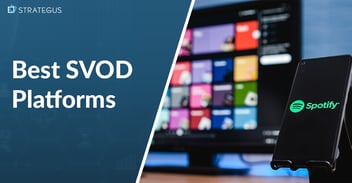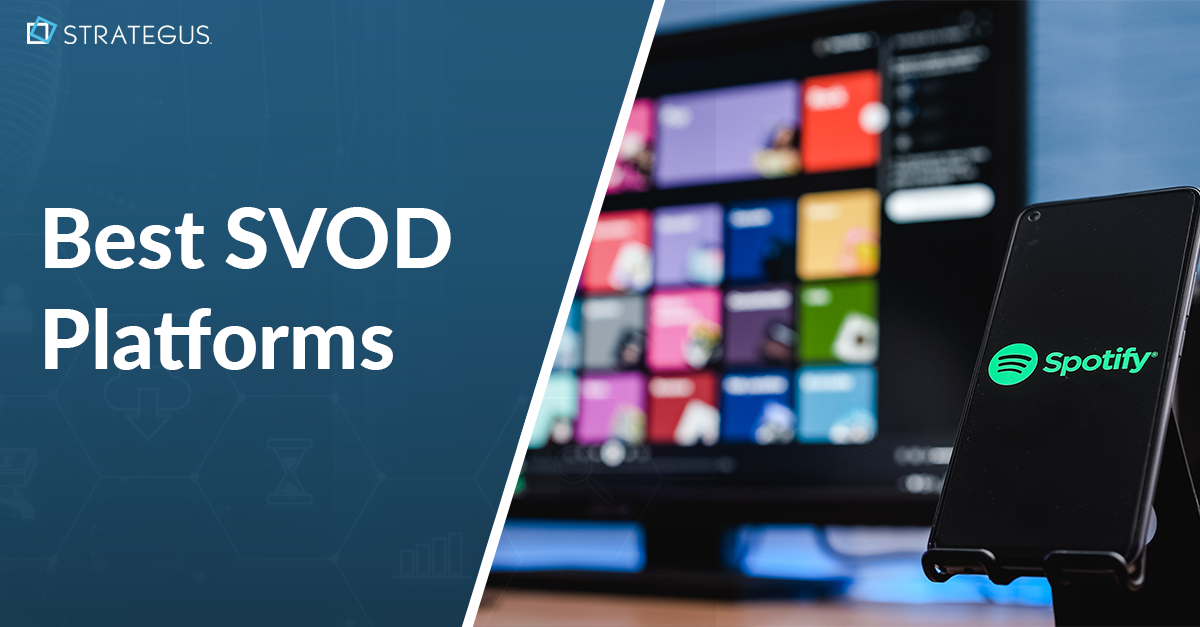- Home
- Strategus Blog
- How To Influence Action with CTV Advertising
How To Influence Action with CTV Advertising
 Andy Dixon
Andy Dixon
8 minutes read

Advertising today holds the opportunity to reach consumers with more digital touchpoints than ever before. And the increasing power of streaming audiences propels new ways advertisers can target audiences and measure success.
In other words, marketing efforts have to account for connected TV (CTV) as these devices become an everyday experience in households.
The increasing options for video streaming expand digital methods to copy the impact of traditional TV advertising. Not only that, CTV transcends linear TV ads across the board.
Most CTV ads are facilitated through programmatic technology, serving pre-roll, display, and audio commercials to niche audience segments.
In addition, CTV’s digital measurement capabilities far surpass linear TV by delivering precise data points over the guesswork.
Earlier this year, the number of streaming audiences surpassed traditional cable viewers, making it more critical than ever for campaigns to adapt to current viewing habits.
Down below, details on how to leverage CTV in your marketing budget demonstrate its ability to generate incremental reach, increase brand engagement, and enhance advertising performance.
Creating Relevant Engagement
-1.webp?width=707&height=435&name=446055b4-bf6b-4c7b-acfb-311a6b6de2f0%20(1)-1.webp)
Viewers don’t hate advertising. They dislike lousy advertising. In particular, ads unrelated to their interests.
Therefore, maintaining the value proposition in advertising is crucial. And delivering ads to consumers who want to purchase improves the ad experience by offering personalization.
CTV advertising applies across industries, too, as hyper-targeted ads lead to online searches, website visits, and in-store visitors.
Here are some of the ways CTV narrows your audience beyond the traditional age, gender, and income segments:
-
Online shopping habits
-
Preferred streaming device
-
Zip-code radius for a localized approach
-
Website visitor retargeting
-
Lookalike modeling based on previous customers
With smartphones often within reach, CTV enables sequential messaging across multiple screens and devices. Plus, retargeting layers the ad exposure based on previous purchases and watching habits to extend consumer engagement at the bottom of the purchase funnel.
Rise of Ad-Supported Streaming Services
On the other side, audiences are realigning their streaming subscriptions because of the overflow of content options.
In response, major streaming providers have introduced ad-supported tiers (AVOD and FAST) to combat subscription fatigue, which opens more opportunities to reach audiences.
As a result, upfront spending on CTV will grow by 34.6% to $6.41 billion this year. For additional perspective, eMarketer forecasted the same expenditure for total CTV advertising in 2019.
From devices to ad-supported services, CTV represents What's next in advertising:
-
225 million total CTV users in the U.S. and growing
-
87% of households own at least one CTV device (only 50% of households in 2014)
-
76% of viewers are willing to watch ads for free video-streaming content
The top reasons marketers utilize CTV advertising include improved attribution measurement, ad frequency control, and performance-based capabilities.
How it Works

Integrating programmatic technology into CTV advertising adds algorithmic solutions and data analytics to marketing.
Programmatic automates ad-buying by taking audience identifiers and applying this information to media buying. Then advertisers gain a competitive advantage by streamlining CTV campaigns in a fragmented digital space.
Additional innovations in targeting and measurement make streaming television so compelling for advertisers. Exceeding the mass reach of linear TV funnels ads to the right audience wherever they watch:
-
Auto dealers can message high-value audiences and drive online and offline traffic
-
Home services can target new and existing homeowners to book more appointments
-
Higher education schools can enhance student enrollment by finding the ideal applicants
Additional industries such as healthcare, service, legal, insurance, and politics all benefit from CTV advertising.
Programmatic CTV delivers a comprehensive way to analyze demographics, online behaviors, and consumer intent. It’s all about data now, and capitalizing on available resources puts your message in front of a responsive audience.
First-party data activation can start campaigns with already-interested consumers, and lookalike modeling tailors this information to broaden audience messaging and reach. Afterward, advanced reporting tools offer data visualization and ad performance results.
Effective Ad Frequency
In the case of ad frequency, more doesn’t always mean better.
Marketers must balance how often a consumer is messaged and the time frame needed to influence an action.
The call to action you want audiences to take can be specific to marketing KPIs, like purchases, newsletter sign-ups, or surveys.
With that in mind, effective frequency should be a core consideration in campaign planning. Again, that’s where measurement is essential.
However, as stated earlier, viewers watch several services across multiple devices. So, measuring these interactions in real-time and seeing exactly where these interactions are happening ensures ad frequency capping.
In walled garden environments, advertisers lose control of data measurement. On the other hand, using programmatic in open advertising ecosystems provides transparent insights into campaign performance, and the flexibility to optimize quickly to changes.
Better Return on Investment

Still, connected TV hasn’t been exercised to the fullest extent relative to linear ad budgets.
CTV is yielding 30% higher than other marketing channels regarding return on investment, even with CTV averaging just 7% of total spending.
Comprehensive measurement shows that streaming TV impacts consumer purchasing decisions for short and long-term results. So media mixes should reflect the audiences you’re trying to reach.
Plus, the quality of impressions often surpasses what traditional TV CPMs can bring. That’s why CTV applies to brand awareness at the top of the purchase funnel and lower funnel attributions.
In fact, CTV does a 20-30% better job on average than any other placement in driving brand engagement metrics due to its specific targeting.
Omnichannel Strategy

Along with programmatic platforms, campaigns can re-engage users who have already watched your ad on TV. Additionally, seasoned providers can run omnichannel strategies to personalize messages on mobile devices.
Essentially, advertisers pick up where the last ad finished.
Instead of reusing the same content across multiple channels, messages can continue the story. And this is where campaigns generate higher engagement.
Returning ads to interested audiences on CTV ensures an audience-centric experience for your target group.
This feedback system gauges effectiveness, and if campaigns target different audiences, tracking will reveal performance based on each audience segment.
Omnichannel vs. Multichannel Advertising
One important distinction to note is that omnichannel differs from multichannel advertising.
Both concepts engage users across platforms, but omnichannel centers around the customer and uses all available media channels.
Multichannel typically emphasizes a specific channel and centers around the product or service.
Omnichannel adapts to the digital landscape with a holistic approach to advertising. It considers that the customer journey now spans multiple channels and touchpoints before conversion.
It delivers consistent brand awareness seamlessly and involves a range of ad formats, like display, video, and audio.
Bringing hundreds of potential contact points from when consumers leave for work in the morning until they watch their favorite show before bed.
Consumers spend an average of seven and a half hours daily with digital media, and two-thirds of the time, they are on the open internet across different channels.
Programmatic CTV holds an abundance of chances to test different types of ads. So it’s probably worth considering something new to your media mix.
Programmatic advertising is constantly changing, and most of its potential has yet to be discovered. Implementing the latest tactics and technology puts your products and services on the cutting edge of marketing and prepares you for the next evolution of advertising.
Proven Experts, Processes, and Pioneers
Even though employing a CTV ad is complex, marketers need to stay relevant and enhance audience reach. Unfortunately, by not addressing it, some brands may be left behind.
Partnering with Strategus is choosing a skilled programmatic CTV provider. Our managed services have a wealth of experience delivering results for agencies and clients — putting them in the position to maximize the latest advertising capabilities.
We manage programmatic ingenuity with superior campaign management to design efficient campaigns by customizing ads to meet your business’s needs.
The Strategus team offers 24/7 campaign management and continues researching and testing new ways to bridge the gap between traditional and digital media.
Contact us today if you are looking for what’s next in OTT/CTV advertising.

Andy Dixon is a seasoned Content Writing Specialist at Strategus, renowned for his expertise in creating engaging and impactful digital content. With over a decade of experience in content creation, Andy has honed his skills in a variety of niches, ranging from technology and marketing to education.
Strategus is a managed services connected TV(CTV) advertising agency with over 60,000+ campaigns delivered. Find out how our experts can extend your team and drive the result that matter most.
Talk to an Expert
Seeking a Custom CTV Strategy That Delivers?
What to read next

Best SVOD Platforms for Advertisers
The streaming wars have a new battlefront, and this time, it's all about your ad budget. Just a few years ago, SVOD meant "no commercials." Now, it...
12 minutes read

Third-Party Data Targeting for CTV: Benefits & Tactics
Third-party data. It’s a term that’s thrown around, and yet few take the time to detail its pros and cons — much less strategies for using...
7 minutes read

First-Party Data Targeting: Benefits and Tactics for CTV Advertising
First-party data is the information that companies collect directly from their customers rather than through intermediaries. Advertisers use this...
10 minutes read

Foot-Traffic Attribution: Tying Ad Impressions to In-Store Visits
The marketing funnel has changed. Today’s shoppers often begin researching products from the comfort of their homes and don’t set foot into a store...
8 minutes read















